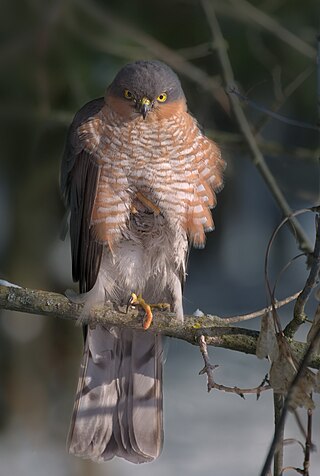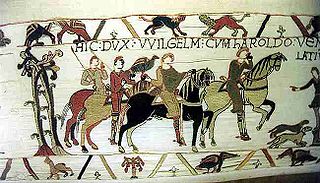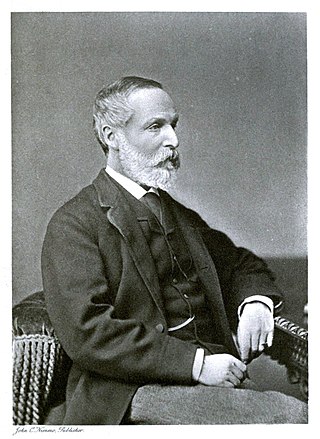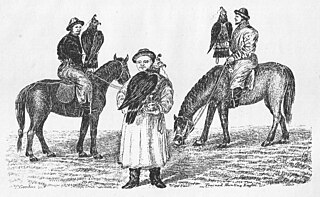Related Research Articles

Hawks are birds of prey of the family Accipitridae. They are very widely distributed and are found on all continents except Antarctica.

Falconry is the hunting of wild animals in their natural state and habitat by means of a trained bird of prey. Small animals are hunted; squirrels and rabbits often fall prey to these birds. Two traditional terms are used to describe a person involved in falconry: a "falconer" flies a falcon; an "austringer" keeps Goshawks and uses accipiters for hunting. In modern falconry, the red-tailed hawk, Harris's hawk, and the peregrine falcon are some of the more commonly used birds of prey. The practice of hunting with a conditioned falconry bird is also called "hawking" or "gamehawking", although the words hawking and hawker have become used so much to refer to petty traveling traders, that the terms "falconer" and "falconry" now apply to most use of trained birds of prey to catch game. However, many contemporary practitioners still use these words in their original meaning.

The merlin is a small species of falcon from the Northern Hemisphere, with numerous subspecies throughout North America and Eurasia. A bird of prey once known colloquially as a pigeon hawk in North America, the merlin breeds in the northern Holarctic; some migrate to subtropical and northern tropical regions in winter. Males typically have wingspans of 53–58 centimetres (21–23 in), with females being slightly larger. They are swift fliers and skilled hunters which specialize in preying on small birds in the size range of sparrows to quail. The merlin has for centuries been well regarded as a falconry bird. In recent decades merlin populations in North America have been significantly increasing, with some merlins becoming so well adapted to city life that they forgo migration.

The Eurasian sparrowhawk, also known as the northern sparrowhawk or simply the sparrowhawk, is a small bird of prey in the family Accipitridae. Adult male Eurasian sparrowhawks have bluish grey upperparts and orange-barred underparts; females and juveniles are brown above with brown barring below. The female is up to 25% larger than the male – one of the greatest size differences between the sexes in any bird species. Though it is a predator which specialises in catching woodland birds, the Eurasian sparrowhawk can be found in any habitat and often hunts garden birds in towns and cities. Males tend to take smaller birds, including tits, finches and sparrows; females catch primarily thrushes and starlings but are capable of killing birds weighing 500 g (18 oz) or more.

The American kestrel, is the smallest and most common falcon in North America. Formerly called "sparrowhawk", a misnomer as it is a true falcon and is unrelated genetically to the Eurasian sparrowhawk, Accipiter nisus. It has a roughly two-to-one range in size over subspecies and sex, varying in size from about the weight of a blue jay to a mourning dove. It also ranges to South America and is a well-established species that has evolved into 17 subspecies adapted to different environments and habitats throughout the Americas. It exhibits sexual dimorphism in size and plumage, although both sexes have a rufous back with noticeable barring. Its plumage is colorful and attractive, and juveniles are similar in plumage to adults.

The red-tailed hawk is a bird of prey that breeds throughout most of North America, from the interior of Alaska and northern Canada to as far south as Panama and the West Indies. It is one of the most common members within the genus of Buteo in North America or worldwide. The red-tailed hawk is one of three species colloquially known in the United States as the "chickenhawk", though it rarely preys on standard-sized chickens. The bird is sometimes also referred to as the red-tail for short, when the meaning is clear in context.

The Accipitrinae are the subfamily of the Accipitridae often known as the "true" hawks. The subfamily contains 73 species that are divided into 11 genera. It includes the genus Accipiter which formerly included many more species. The large genus was found to be non-monophyletic and was split into several new or resurrected genera. The birds in this subfamily are primarily woodland birds that hunt by sudden dashes from a concealed perch, with long tails, broad wings and high visual acuity facilitating this lifestyle.

The shikra is a small bird of prey in the family Accipitridae found widely distributed in Asia and Africa where it is also called the little banded goshawk. The African forms may represent a separate species but have usually been considered as subspecies of the shikra. The shikra is very similar in appearance, as well as behavior, at least to some degree, to other species including the Chinese sparrowhawk, Eurasian goshawk and Eurasian sparrowhawk. They have a sharp two-note call and exhibit the flap-and-glide flight style typical of Tachyspiza and Accipiter hawks. Their calls are imitated by drongos and the common hawk-cuckoo resembles it in plumage. This species was formerly placed in the genus Accipiter.
Takagari is Japanese falconry, a sport of the noble class, and a symbol of their nobility, their status, and their warrior spirit.

The prairie falcon is a medium-large sized falcon of western North America. It is about the size of a peregrine falcon or a crow, with an average length of 40 cm (16 in), wingspan of approximately 1 meter (40 in), and average weight of 720 g (1.6 lb). As in all falcons, females are noticeably bigger than males. Though a separate species from the peregrine, the prairie falcon is basically an arid environment divergence of the early peregrine falcon lineage, able to subsist on less food than the peregrine, and generally lighter in weight than a peregrine of similar wing span. Having evolved in a harsh desert environment with low prey density, the prairie falcon has developed into an aggressive and opportunistic hunter of a wide range of both mammal and bird prey. It will regularly take prey from the size of sparrows to approximately its own weight, and occasionally much larger. It is the only larger falcon native only to North America. It is resident from southern Canada, through western United States, and into northern Mexico. The prairie falcon is popular as a falconry bird, where with proper training it is regarded as being as effective as the more well known peregrine falcon.

Royal hunting, also royal art of hunting, was a hunting practice of the aristocracy throughout the known world in the Middle Ages, from Europe to Far East. While humans hunted wild animals since time immemorial, and all classes engaged in hunting as an important source of food and at times the principal source of nutrition, the necessity of hunting was transformed into a stylized pastime of the aristocracy. In Europe in the High Middle Ages the practice was widespread.
The North American Falconers Association (NAFA) is a falconry organization composed primarily of falconers.
Training raptors is a complex undertaking. Books containing advice by experienced falconers are still rudimentary at best. Many important details vary between individual raptors, species of raptors and between places and times. The keeping and training of any raptor is strictly and tightly regulated by U.S. state and federal laws. Anyone in the USA who is interested in flying raptors must seek out a state and federally licensed falconer to sponsor them through an apprenticeship period lasting two years at a minimum, and often considerably longer.
Hacking is a training method that helps young birds of prey reach their hunting potential by giving them exercise and experience. This technique is used to prepare the falcon to become an independent hunter. The sequence of the procedure includes captivity, releasing, flight, and either the falcon will be recaptured for falconry or released into the wild. This has also been adapted to other raptor species to preserve the population. Generally, falconers agree that hacked falcons are better and more preferred in the field. Hacking is beneficial, not only for the falconers, but for the bird itself and the species; however, there are some criticism and restrictions that come along with this method.

Lorant de Bastyai was a member of the international falconry community. He is perhaps best known in the United Kingdom for establishing the Welsh Hawking Club. He was also an honorary member of the British Falconers Club, the Hawking Club of Great Britain, the North American Falconry Club, the Austrian, German and French Associations. He was born in Szeged, Hungary in 1910. His father's love of hunting, horses and racing pigeons fuelled Lorant's early passion for nature and birds in particular. A chance encounter with a visiting British falconer launched a career that would span 60 years and have a profound impact in reviving a sport that had become all but extinct.

Phillip Edward Brougham Glasier was Britain's leading expert on hawking and falconry. Glasier initiated a new interest in falconry in both the UK and the United States of America. He spent much of his life involved with the conservation and breeding of raptors and bringing them to public attention through the foundation of the Falconry Centre, Newent, Gloucestershire, as well as through books, lectures and public demonstrations. He founded the Hawk Trust with John Burkett and the Raptor Breeders' Association.

The Eurasian goshawk is a species of medium-large bird of prey in the family Accipitridae, a family which also includes other extant diurnal raptors, such as eagles, buzzards and harriers. It was formerly placed in the genus Accipiter. It is a widespread species that inhabits many of the temperate parts of the Eurasia. Except in a small portion of southern Asia, it is the only species of "goshawk" in its range and it is thus often referred to, both officially and unofficially, as simply goshawk. It is mainly resident, but birds from colder regions migrate south for the winter. As of 2023, goshawks found in North America are no longer considered be conspecific, but are now designated as the American goshawk.

Francis Henry Salvin (1817–1904) was an English writer on falconry and cormorant-fishing.

Gage Earle Freeman (1820–1903) was an English clergyman, known as a writer on falconry.

Mankind has been fascinated by the golden eagle as early as the beginning of recorded history. Most early-recorded cultures regarded the golden eagle with reverence. Only after the Industrial Revolution, when sport-hunting became widespread and commercial stock farming became internationally common, did humans started to widely regard golden eagles as a threat to their livelihoods. This period also brought about the firearm and industrialized poisons, which made it easy for humans to kill the evasive and powerful birds. The following are various reportages of the significance of eagles, many likely pertaining to the golden eagles, in early cultures and older religions as well as national and military insignias.
References
- ↑ Mullenix, Matt. "Principles & Opinions". A Falconry Site. Archived from the original on 20 January 2012. Retrieved 10 November 2011.